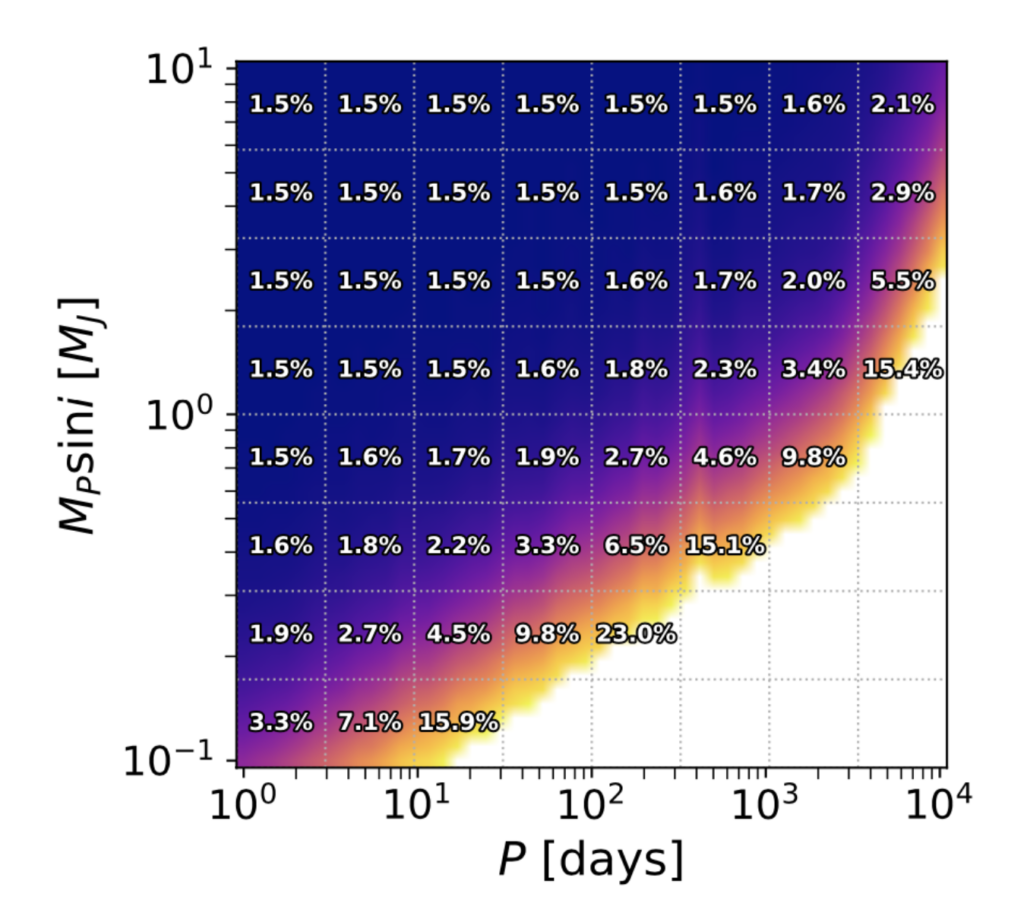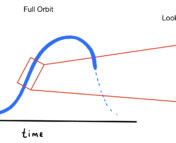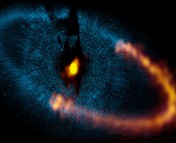Title: Mid-to-Late M Dwarfs Lack Jupiter Analogs
Authors: Emily K. Pass, Jennifer G. Winters, David Charbonneau, Jonathan M. Irwin, David W. Latham, Perry Berlind, Michael L. Calkins, Gilbert A. Esquerdo, Jessica Mink
First Author’s Institution: Center for Astrophysics, Harvard & Smithsonian
Status: available on the arXiv [open access]
The most common type of star in the Universe is the M Dwarf, representing some ~70% of all stars. M dwarfs are much smaller in mass and radius than our Sun and they are much cooler in temperature. Because of these three factors, they have been high priority targets of exoplanet surveys over the years for a few reasons. First, their small mass means that for a given planet mass, the radial velocity semi-amplitude is larger and therefore easier to detect. Similarly, given an M dwarf’s small radius, for a given planet radius, the transit depth will be larger, and therefore easier to detect. Lastly, because of their cooler temperatures, the Habitable Zone for M dwarfs is much closer to the star. This makes it easier to detect planets from both the radial velocity (RV) and the transit method. For all these reasons, it should be very easy to detect giant planets, like Jupiter, in M dwarf systems. However, we have found very few Jupiter-sized or Jupiter-like planets orbiting M dwarfs, but found them to be common around stars of other spectral types.
This begs the question, why? Why do giant planets form around some stars and not others? What is special about M dwarf stars that inhibits giant planet formation? Are we really not finding these planets around M dwarfs, or are we getting unlucky in where and how we search? A new paper titled, Mid-to-Late M Dwarfs Lack Jupiter Analogs, seeks to answer some of these questions.
The team realized that the first step in answering any of these questions is to determine exactly what the occurrence rate is of giant planets around M dwarf stars. Occurrence rate studies set out to determine how often a particular type of planet, usually defined as existing within some parameter space of mass or radius along with orbital period, exists around a particular type of star, usually defined as within some range of stellar mass. In this case, the occurrence rate of giant planets around M dwarfs has been estimated before.
But the authors of this paper point to a few flaws in previous methodologies. First, prior works do not specifically target M dwarfs, rather all stars. This lowers the amount of time spent observing M dwarf stars and therefore lowers the chance of actually finding a planet. Second, these surveys have not specifically targeted late M dwarfs. In stellar classification, we often denote stars within the same class as early or late, with early meaning the hottest (aka highest mass) stars within the class, and late meaning the coolest (aka lowest mass) stars within the class. The late M dwarf stars are the smallest stars in the Universe and very little is known about their planet formation rate, or occurrence rate.
To determine the occurrence rate of giant planets around late M dwarf stars, the authors designed a unique survey. They took every M dwarf within 15 parsecs (~50 lightyears) of Earth, removed binaries, active stars, and early M dwarfs, leaving behind only the smallest mass, well-behaved (in terms of activity) single stars nearest to Earth; this resulted in 200 stars. Then, over a 3 year timespan, they collected 4 RVs of each star. Four observations is not very many but the team determined a way to make this work for them. Instead of trying to measure the entire orbit of a giant planet and fit for parameters such as mass and orbital period, their aim was to confidently say whether a star hosted a giant planet. They accomplished this by looking at the scatter in the 4 RVs. RV data sets that contain a planetary signal should have higher scatter than data sets where there is no planet signal. This is because if you randomly sample the orbit of planet, you’ll get velocities from different parts of the orbit which will have different values from one another. But for no planet in the system, there is no velocity signal and so you should get a roughly flat line in your RV data set.
The team then used statistical tests to determine if there was any meaningfully significant scatter in the 4 RV observations they collected for each star. But additionally, the team had to quantify their survey completeness. That is, given how often they sampled each star’s radial velocity, how often would they expect to find a planet with a certain mass and orbital period if such a planet truly existed in the data. Another way of putting this is, how often would they miss a true planet. To determine completeness, the team performed an Injection/Recovery test. Here, they take the true timestamps and error bars for each star, one at a time, and inject a signal for a planet with a given mass and orbital period, then test how well they recover the signal using the same statistical techniques as they use on the real data. See Figure 1 below for results of this test: they are very sensitive to giant planets at all orbital periods.

Overall, the team finds two candidate giant planet signals; however with additional follow up observations, they determine that there are in fact no planets in those two systems. Overall, the team was then able to compute the occurrence rate of giant planets around late M dwarf stars: 1.5%. This is a small number and it represents how rare these types of systems are, only 1.5% of M dwarf stars host a giant planet out to the snow line, the distance from the host star to where is is cold enough for volatiles, like ices, to condense; then they can then be accreted onto a forming planet.
The team summarize how their result might be used to better understand planet formation and the role of giant planets in system architecture. Perhaps, as others have suggested, core accretion as a planet formation mechanism is inhibited for small stellar mass hosts. This may have far larger reaching impacts on system development as a whole. The authors note how other studies have found that giant planets might themselves inhibit small planet formation by blocking the necessary building blocks from reaching the inner solar system. Therefore, a dearth of giant planets around late M dwarfs might mean a surplus of small planets. In all the authors conclude that while their occurrence rate finding is low, they wish to extend the study to active M dwarf stars and expand their sample.
Astrobite edited by Maryum Sayeed
Featured image credit: Pass et al. 2023




